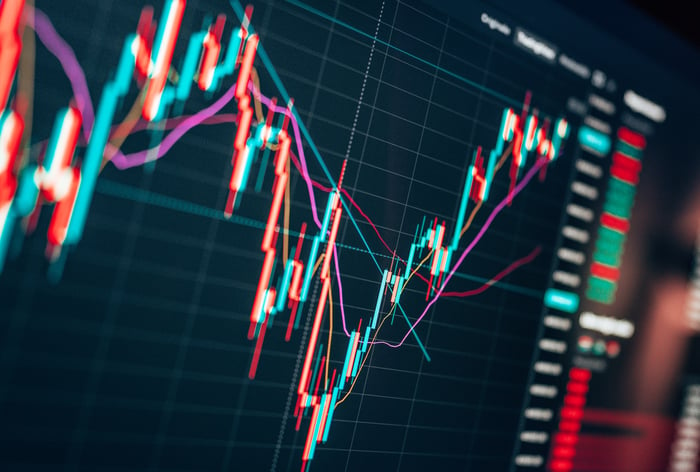There's no sugarcoating it: Wall Street has had a miserable year. Since hitting a record-closing high during the first week of January, the widely followed S&P 500 has lost as much as 24% of its value and tumbled into bear market territory.
But it's been an even tougher go for growth-dependent stock indexes, such as the Nasdaq Composite and Nasdaq 100. The latter is comprised of the 100 largest nonfinancial stocks listed on the Nasdaq exchange. Since hitting their all-time highs, both the Nasdaq Composite and Nasdaq 100 have shed close to a third of their value at their peak.

Image source: Getty Images.
But there's another side to this story. While bear market declines can be scary, they're also the ideal time for long-term investors to do some shopping. This is especially true for growth stocks, which have taken it on the chin during the 2022 swoon in equities. The Nasdaq 100 is currently housing three bargain growth stocks that can confidently be bought hand over fist in August.
Amazon
The first Nasdaq 100 stock that proved, once again, it belongs in investors' portfolios and can be bought hand over fist in August is e-commerce stock Amazon (AMZN 1.11%).
In each of the past two quarters, U.S. gross domestic product (GDP) retraced. This comes atop persistent supply chain issues caused by the COVID-19 pandemic, as well as historically high inflation, which hit a four-decade high of 9.1% in June. In other words, Wall Street and investors fully expected Amazon to face-plant when it reported its second-quarter operating results. While there were a number of one-time charges that weighed on the company's bottom line, the fact remains that its high-margin operating segments and long-term growth trajectory remain unfazed by near-term economic weakness.
The interesting thing about Amazon is that its most well-known operating segment may prove to be its least important over the long run. On the one hand, Amazon's online marketplace is expected to account for 39.5% of U.S. online retail sales in 2022. That's more than its next-closest 14 competitors added together. On the other hand, retail is a low-margin segment.
What's far more important for Amazon is how its marketplace has helped funnel business into its higher-margin segments. For instance, the company's leading marketplace helped it sign up more than 200 million Prime members. The tens of billions of dollars collected in annual Prime fees allow Amazon to invest in its rapidly growing logistics network and redirect capital to high-margin initiatives.
Arguably the highest-margin initiative for the company is Amazon Web Services (AWS). According to a report from Canalys, AWS accounted for 33% of global cloud infrastructure spending in the first quarter. AWS managed 33% year-over-year sales growth in the challenged second quarter and has consistently provided the lion's share of Amazon's operating income despite accounting for around 15% to 16% of net sales.
The final reason to pile into Amazon is its valuation. After more than a decade of investors willingly paying 20 or more times year-end cash flow, investors can buy Amazon right now for a little over nine times Wall Street's forecast cash flow in 2025.
PayPal Holdings
The second Nasdaq 100 stock that's begging to be bought in August is fintech giant PayPal Holdings (PYPL 2.34%). PayPal is the parent of popular peer-to-peer payment app Venmo.
The prevailing concern for digital payment companies over the past couple of quarters is that inflation would adversely impact their operating performance. Rising prices disproportionately impact lower-earning deciles, which has the potential to result in reduced usage on digital payment platforms. Although PayPal has, indeed, sounded a cautious tone over the short run, the theme of this list is that its long-term growth strategy remains well intact.
For instance, PayPal managed to deliver 15% constant-currency growth in total payment volume on its platform during Q1 (note, this write-up was done prior to PayPal reporting Q2 results on Aug. 2, 2022). Not only does this demonstrate that consumer spending is stronger than some folks realize, but it suggests that digital payments are still in their infancy and capable of sustained, double-digit growth for a long time to come.
What's more, engagement across PayPal's digital platforms has been steadily climbing. At the end of 2020, active users were completing an average of 40.9 transactions over the trailing-12-month period. But as of the end of Q1 2022, the average active user was undertaking 47 transactions over the trailing-12-month period. If this figure keeps rising, it suggests PayPal should have no trouble extracting increasingly larger profits out of its growing active users.
PayPal also expects to be a sizable player in the buy now, pay later (BNPL) space. While most BNPL businesses are likely to see delinquencies rise as the U.S. and global economy worsens in the coming quarters, the future for financed digital purchases appears bright. It's why PayPal ponied up $2.7 billion to acquire BNPL provider Paidy in Japan in 2021.
Over the past five years, PayPal has averaged a forward-year price-to-earnings (P/E) ratio of 38.1. Investors can scoop up shares right now for less than half that amount (18.3 times forward-year earnings).

Image source: Getty Images.
Alphabet
The third Nasdaq 100 stock to buy hand over fist in August is none other than FAANG stock Alphabet (GOOGL 1.52%) (GOOG 1.44%). Alphabet is the parent company of widely used internet search engine Google and streaming platform YouTube.
Any skepticism toward Alphabet effectively echoes what's already been said about Amazon and PayPal. With the U.S. in what some might consider to be a "recession" after two consecutive quarterly GDP declines, there's the belief that ad revenue will take a sizable hit. Since Alphabet generates the bulk of its sales from ads, there's a possibility it could see sales and profits decline as the U.S. and global economy weaken. But this only tells a small sliver of the company's growth story.
To begin with, Google might as well be considered a monopoly in the internet search space. For the past two years (through June 2022), it's controlled up to a 93% global share of internet search. With the next-closest competitor 88 percentage points in the rearview mirror, it's no wonder the company is able to command such excellent pricing power on its ads. Save for the initial stages of the pandemic that led to lockdowns, Google has consistently grown by a double-digit percentage for more than two decades.
But just like Amazon, it's not Alphabet's foundation that is its most exciting segment. Rather, it's the numerous revenue offshoots that offer superior growth potential throughout the decade.
For instance, YouTube has become one of the most visited social media sites on the planet, with 2.56 billion monthly active users. Based on Alphabet's Q2 results, YouTube is generating an annual run rate of more than $29 billion in ad revenue (not including subscriptions).
There's also Google Cloud, which is Alphabet's cloud infrastructure service segment. It was the global No. 3 in cloud spending during Q1, with 8% market share, per Canalys. Even though Google Cloud is weighing on Alphabet's bottom line for the moment, the high margins typically associated with cloud services should help it become a positive driver of operating cash flow sooner than later.
At no point in Alphabet's storied history has it ever been this inexpensive relative to Wall Street's forward-year earnings forecast or cash flow projections. That makes Alphabet perhaps the smartest buy on this list and within the Nasdaq 100 right now.





